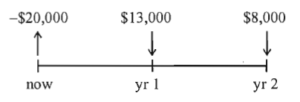6.1 Evaluating a Business Plan
Example 6.1.1
Suppose a business plan would require an investment of $20,000 now and would result in cash flows of $13,000 in one year and $8,000 in two years.

Then, if you ignore (just for a moment!) the time value of money, you can see that:
[latex]\begin{align*} Profit&=Revenue- Expense\\ &=$21,000 -$20,000\\ &=$1,000 \end{align*}[/latex]
showing a positive profit.
Key Takeaways
A positive profit is a minimum requirement for a successful investment. No company would choose investments which they expect to result in a loss.
Beyond this the question is: How can we decide whether this investment is preferable to others?
Suppose that an alternative investment was to place the money in a trust account which would pay 6% effective over the two-year period, and from which withdrawals could be made at any time.
Then, if you try to match the sequence of cash flows you would have:
| Time | Interest | Deposit | Withdrawal | Balance |
| 0 | $20,000.00 | $0.00 | $20,000.00 | |
| 1 | $1,200.00 | 13,000.00 | 8,200.00 | |
| 2 | 492.00 | 8,000.00 | 692.00 |
The final balance of $692.00 shows that in the account we could have withdrawn a total payment of $8,692 at the end of the second year, which is more than the original investment would allow; hence, the trust company account would be a better investment. The first investment made money, but not fast enough to earn 6% effective.
Your Own Notes
- Are there any notes you want to take from this section? Is there anything you’d like to copy and paste below?
- These notes are for you only (they will not be stored anywhere)
- Make sure to download them at the end to use as a reference

